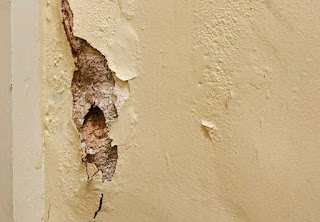How can you recognise penetrating damp in the house?
Recognising penetrating damp is not always an easy task. This is mainly because this type of damp problem can occur in places in the house that are difficult to reach. Places where you don’t usually go and where the damp problem can damage the house unnoticed. Any type of damp can be recognised mainly by the musty smell in the house, it is not always easily visible. In order to find out where the penetrating damp is, it is important to inspect the outside wall for damp spots or discolouration. If there are holes or cracks in the wall, these are usually the main causes of damp penetrating into the inner wall.
Cause 1: Porous facades
A main cause of penetrating damp is a porous (permeable) facade. The facade is naturally porous and consists of bricks and brickwork. A wall must be able to breathe, so it is normal for the outer wall to be porous. When there is a long period of precipitation in the United Kingdom, the wall is filled with damp (due to rainwater). When the sun shines again, the wall dries up quickly. But is the outside wall in the shade, is the wall full of vegetation or is it outdated, with hardly any maintenance? If so, there is a good chance that the wall will not be able to dry sufficiently and that will result in penetrating damp.
Cause 2: Damaged exterior walls
Damaged walls can also allow damp to penetrate easily from the outside to the inside. Cracks and holes in the brickwork are weak spots that cause damp to permeate into the house. At first, there can be small cracks in the outside wall, but because of the damp, these can become bigger and bigger, which makes the damp problem even worse. Damaged outer walls therefore need to be repaired quickly; this is especially the case with old houses.
Cause 3: Paint layers and plasters
On the one hand, layers of impermeable paint and plaster are used to protect a wall against damp from the outside; on the other hand, they can ensure that a wall remains damp and cannot dry properly as they block the walls ability to breathe, and as a result the walls do not dry (or dry less quickly). The protective effect of the layers of paint and plaster is counterproductive.
Cause 4: A broken roof gutter
Another cause of penetrating damp can be a broken gutter. There may even just be a problem with the connection between the gutter and the fall pipe which in turn causes leaks. If you notice a damp problem in the house with noticeable damp spots at the level of the leaves, then it is certainly worth checking the gutters. A dirty gutter can also cause damp to penetrate the house.
Cause 5: Cracks around windows and frames
There can also be cracks and weak spots around windows and window frames, these weak spots cause water to penetrate from outside to inside. The same goes for missing sills around doors and windows. It is often quite a task to discover the exact cause of leakage of damp in the house. In most cases it is a combination of several factors. In addition, damp damage can occur in several places in the house and can usually be traced back to just one cause.
For More Info Visit At:-->




Comments
Post a Comment